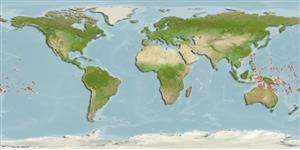>
Holocentriformes (Squirrelfishes, soldierfishes) >
Holocentridae (Squirrelfishes, soldierfishes) > Myripristinae
Etymology: Myripristis: Greek, myros, -ou = male of morey eel + Greek, pristis = saw (Ref. 45335).
More on author: Greenfield.
Environment: milieu / climate zone / depth range / distribution range
Écologie
marin récifal; profondeur 2 - 20 m (Ref. 86942). Tropical; 26°N - 24°S
Pacific Ocean: islands of Oceania except Hawaii, Easter Island, Pitcairn Group or islands off the Plate such as Solomon Islands and New Caledonia. Also Caroline Islands to the Line Islands (Kiribati); north to Bonin and Marcus Islands; south to Samoa and Tuamoto Islands, including Micronesia (Ref. 1602).
Taille / Poids / Âge
Maturity: Lm ? range ? - ? cm
Max length : 26.5 cm TL mâle / non sexé; (Ref. 89972)
Épines dorsales (Total) : 11; Rayons mous dorsaux (Total) : 13 - 14; Épines anales: 4; Rayons mous anaux: 10 - 13. This species is the only Micronesian large-scaled Myripristis that lacks scales on its inner pectoral axil. It also differs by having a white spot on the upper inner pectoral axil and combination of dark red (versus black) opercular membrane, dark red or purple pectoral axil, distinct white ring around the iris, an white anterior margins of its pelvic an soft rayed fins.
Inhabits reef flats, lagoons, and seaward reefs (Ref. 9710). Commonly found on exposed outer-reef areas; often at low islands and atolls than high islands (Ref. 12419). Feeds on zooplanktons (Ref. 89972).
Life cycle and mating behavior
Maturities | Reproduction | Spawnings | Egg(s) | Fecundities | Larves
Randall, J.E. and D.W. Greenfield, 1996. Revision of the Indo-Pacific holocentrid fishes of the genus Myripristis, with descriptions of three new species. Indo-Pac. Fish. (25):61 p. (Ref. 12419)
Statut dans la liste rouge de l'IUCN (Ref. 130435)
Menace pour l'homme
Harmless
Utilisations par l'homme
Pêcheries: commercial
Outils
Articles particuliers
Télécharger en XML
Sources Internet
Estimates based on models
Preferred temperature (Ref.
123201): 25.7 - 29.4, mean 28.3 °C (based on 1027 cells).
Phylogenetic diversity index (Ref.
82804): PD
50 = 0.5000 [Uniqueness, from 0.5 = low to 2.0 = high].
Bayesian length-weight: a=0.02512 (0.01522 - 0.04145), b=2.97 (2.83 - 3.11), in cm total length, based on LWR estimates for this species & Genus-body shape (Ref.
93245).
Niveau trophique (Ref.
69278): 3.5 ±0.5 se; based on size and trophs of closest relatives
Résilience (Ref.
120179): Haut, temps minimum de doublement de population inférieur à 15 mois (Preliminary K or Fecundity.).
Fishing Vulnerability (Ref.
59153): Low vulnerability (17 of 100).
Nutrients (Ref.
124155): Calcium = 67.2 [30.9, 196.3] mg/100g; Iron = 0.703 [0.290, 1.430] mg/100g; Protein = 18.6 [17.5, 19.8] %; Omega3 = 0.148 [0.061, 0.337] g/100g; Selenium = 28.7 [17.0, 52.4] μg/100g; VitaminA = 72 [27, 188] μg/100g; Zinc = 1.36 [0.89, 2.08] mg/100g (wet weight);
